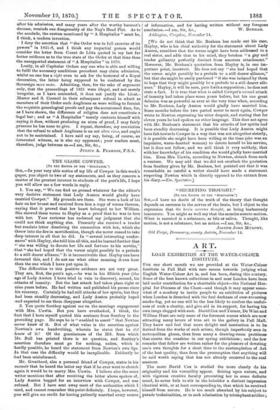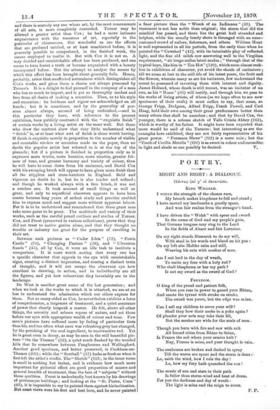A RT.
LOAN EXHIBITION AT THE WATER-COLOUR INSTITUTE.
FOR one short month we are provided at the Water-Colour Institute in Pall Mall with rare means towards judging what English Water-Colour Art is, and has been, during this century. Some of the best known collections in and near London have been laid under contribution for a charitable object—the National Hos- pital for Diseases of the Chest—and though it may appear some- what of a mockery to invite people to an exhibition of pictures when London is drenched with the foul darkness of ever-recurring smoke-fog, yet no one will be the less likely to confess the useful- ness of such a charity, and give aid in its support, for having his own lungs clogged with soot. David Cox and Turner, De Wint and William Hunt are only some of the foremost names which are now attracting many lovers of true art to the gallery in Pall Mall. They know and feel that more delight and instruction is to be derived from the works of such artists, though imperfectly seen in metropolitan gloom, than from many a drawing-room prettiness that courts the sunshine in our spring exhibitions ; and the few remarks that follow are written rather for the pleasure of devoting one's own thoughts for a short time to the contemplation of Art of the best quality, than from the presumption that anything will be said worth saying that has not already occurred to the real amateur.
The more David Cox is studied the more clearly do his originality and his versatility appear. Seizing upon nature, and with vigorous creative faculty presenting her in some definite mood, he never fails to stir in the beholder a distinct impression identical with, or at least corresponding to, that which he received himself from nature. He is too much absorbed by his subject to parade technicalities, or to seek admiration by triumphant artifice;
and there is scarcely any one whose art, by the most consummate of .all arts, is more completely concealed. Turner may be allowed a greater artist than Cox ; he had a more intimate acquaintance with the resources of art, especially in the particular of chiaroscuro. But wonderful as are the effects that are produced untried, or at least unachieved before, it is generally possible to comprehend, in the finished work, the means employed to realize it. But with Cox it is not so. A. very decided and unmistakable effect has been produced, and one seems to have learnt a truth or become acquainted with a beauty unsuspected before. But the attempt to analyse the means by which this effect has been brought about generally fails. Hence, probably, arises that unaffected naturalness which distinguishes all Cox's works, and gives them a charm not always possessed by Turner's. It is a delight to feel yourself in the company of a man who has so much to impart, and is yet so thoroughly modest and free from all desire of making a sensation. Then, as to his style and execution : its boldness and vigour are acknowledged on all hands ; but it is sometimes, and by the generality of per- sons almost always, accused of being unfinished,—and in this particular they have, with reference to the present exhibition, been publicly contrasted with the "exquisite finish" of certain works by a living artist on the same wall. But those who draw the contrast show that they little understand what "finish" is, or at least what sort of finish is alone worth having. If finish is exquisite merely in proportion to the number of visible and countable strokes or scratches made on the paper, then no doubt the popular artist last referred to is at the top of the pinnacle ; but if a picture is finished in proportion only as it expresses more truths, more beauties, more niceties, greater ful- ness of tone, and greater harmony and variety of colour, then he will have to come down from his eminence, and David Cox with his sweeping brush will appear to have given more finish than all the stipplers and cross-hatchers in .England. Bold and vigorous no doubt be is, but he is also tender and refined ; and though he worked always with a free brush, it was not a careless one. It took account of small things as well as great, and only to superficial observers appears to have been coarse because long years of ardent study and practice enabled him to express much and suggest more without apparent labour. For it is to be understood and remembered that these great men take some pains to be great. The multitude and variety of their works, such as the careful pencil outlines and studies of Turner, Cox, and Prout (preserved in various collections), prove that they did not trust to native genius alone, and that they thought no trouble or industry too great for the purpose of excelling in their art.
Between such pictures as " Cader Idris " (72), " Powis Castle" (34), "Changing Pasture" (28), and " Ulverston Sands" (45), all by Cox, it were an idle task to institute a comparison. It is more worth .noting that every one has a specific character that appeals to the eye with unmistakable signs, creating a distinct impression, and rousing a distinct train of thought, and it will not escape the observant eye how excellent in drawing, in action, and in individuality are all the figures, and yet how subservient they invariably are to the landscape.
De Wint is another great name of the last generation ; and when we look at the works to which it is attached, we are at no loss to understand the admiration which our elders express for them. Not so many-sided as Cox, he nevertheless exhibits a force of comprehension, a largeness of treatment, and a quiet assurance of power that clearly bespeak a master. He felt, above all other things, the serenity and solemn repose of nature, and set them before our eyes with appropriate wealth of colour and tone. Few men's pictures have suffered more by fading of particular tints than his, and too often what once was refreshing gray has changed, by the perishing of the cool ingredient, to unattractive red. Yet he is great even in decay, as may be seen in the still beautiful pic- ture "On the Thames" (52), a quiet reach flanked by the wooded hills that lie somewhere between Pangbourne and Wallingford. Another good specimen, and better preserved, is Cookham-on- Thames (209) ; while the " Southall" (17) looks as fresh as when it first left the artist's studio. The "Sketch" (153), in the inner room is small in nothing but inches, and is evidence how much more important for pictorial effect are good proportion of masses and general breadth of treatment, than the best of " subjects " without those qualities. Front is undoubtedly best known by his drawings of picturesque buildings ; and looking at the "St. Pierre, Caen" (43), it is impossible to say he painted them against his inclination. But coast views were his first and best love, and he never painted
a finer picture than the "Wreck of an Indianian" (49). The- treatment is not less noble than original; the storm that did the mischief has passed, and there lies the great hull stranded and. helpless, while the usually lonely shore is thronged with an unac- customed crowd of sailors, fishermen, and others. William Hunt is well represented in all his periods, from the early time when he painted the " Cowshed " (42), with its inimitable play of reflected. light, and the fine old milch cow answering well to the Virgilian, requirement, "sit longo nullus lateri modus ; " through that of the typical boys, like him in "Too Hot" (120), which seem almost reck- less in exhibition of character, yet avoid the shoals of caricature ; till we come at last to the still life of his latest years, the fruit and the flowers, wherein many as are his imitators, few understand the secret he possessed of investing them with interest and dignity.. James Holland, whose death is still recent, was an imitator of no one, as his "Roses" (66) will testify, and through him we pass to- the works of living artists, of whom (as we hope often to see new specimens of their craft) it must suffice to say, that some, as- George Fripp, Dodgson, Alfred Fripp, Frank Powell, and Carl. Haag, hold their own among their great predecessors better than many others that shall be nameless ; and that by David Cox, the- younger, there is a solemn sketch of Valle Crucis Abbey (163), which is worthy of his father. It might have been expected that. more would be said of the Turners ; but interesting as are the examples here exhibited, they are not fairly representative of his. great power. " Penmaen Mawr" (222) is a mere ruin ; but the "Tomb of Cecilia Metella " (226) is as sweet in colour and recondite
in light and shade as can possibly be desired. V..



































 Previous page
Previous page